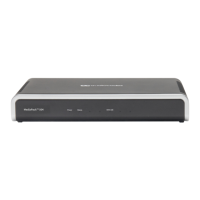Version 6.2 311 February 2011
SIP User's Manual 9. VoIP Networking Capabilities
9 VoIP Networking Capabilities
This section provides an overview of the device's VoIP networking capabilities.
9.1 Ethernet Interface Configuration
The device's Ethernet connection can be configured (using the ini file parameter
EthernetPhyConfiguration) for one of the following modes:
Manual mode:
• 10Base-T Full-Duplex
• 100Base-TX Half-Duplex or 100Base-TX Full-Duplex
Auto-Negotiation: chooses common transmission parameters such as speed and
duplex mode
The Ethernet connection should be configured according to the following recommended
guidelines:
When the device's Ethernet port is configured for Auto-Negotiation, the opposite port
must also operate in Auto-Negotiation. Auto-Negotiation falls back to Half-Duplex
mode when the opposite port is not in Auto-Negotiation mode, but the speed in this
mode is always configured correctly. Configuring the device to Auto-Negotiation mode
while the opposite port is set manually to Full-Duplex is invalid as it causes the device
to fall back to Half-Duplex mode while the opposite port is Full-Duplex. Any mismatch
configuration can yield unexpected functioning of the Ethernet connection.
When configuring the device's Ethernet port manually, the same mode (i.e., Half
Duplex or Full Duplex) and speed must be configured on the remote Ethernet port. In
addition, when the device's Ethernet port is configured manually, it is invalid to set the
remote port to Auto-Negotiation. Any mismatch configuration can yield unexpected
functioning of the Ethernet connection.
It's recommended to configure the port for best performance and highest bandwidth
(i.e., Full Duplex with 100Base-TX), but at the same time adhering to the guidelines
listed above.
Note that when remote configuration is performed, the device should be in the correct
Ethernet setting prior to the time this parameter takes effect. When, for example, the device
is configured using BootP/TFTP, the device performs many Ethernet-based transactions
prior to reading the ini file containing this device configuration parameter. To resolve this
problem, the device always uses the last Ethernet setup mode configured. In this way, if
you want to configure the device to operate in a new network environment in which the
current Ethernet setting of the device is invalid, you should first modify this parameter in the
current network so that the new setting holds next time the device is restarted. After
reconfiguration has completed, connect the device to the new network and restart it. As a
result, the remote configuration process that occurs in the new network uses a valid
Ethernet configuration.
9.2 NAT (Network Address Translation) Support
Network Address Translation (NAT) is a mechanism that maps a set of internal IP
addresses used within a private network to global IP addresses, providing transparent
routing to end hosts. The primary advantages of NAT include (1) Reduction in the number
of global IP addresses required in a private network (global IP addresses are only used to
connect to the Internet); (2) Better network security by hiding its internal architecture.

